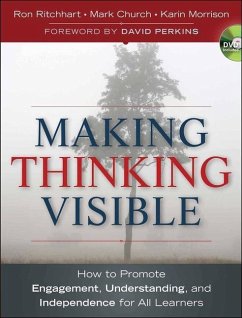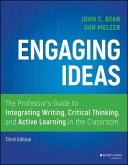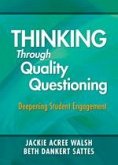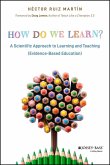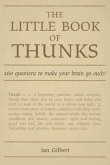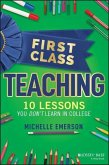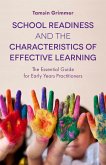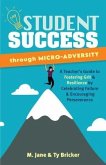Ron Ritchhart (Harvard Graduate School of Education), Mark Church (MI Traverse City Area Public Schools), Karin Morrison (Janusz Korczak Association Australia)
Making Thinking Visible
How to Promote Engagement, Understanding, and Independence for All Learners
28,99 €
inkl. MwSt.
Versandfertig in über 4 Wochen

14 °P sammeln
Ron Ritchhart (Harvard Graduate School of Education), Mark Church (MI Traverse City Area Public Schools), Karin Morrison (Janusz Korczak Association Australia)
Making Thinking Visible
How to Promote Engagement, Understanding, and Independence for All Learners
- Broschiertes Buch
- Merkliste
- Auf die Merkliste
- Bewerten Bewerten
- Teilen
- Produkt teilen
- Produkterinnerung
- Produkterinnerung
A proven program for enhancing students' thinking and comprehension abilities Visible Thinking is a research-based approach to teaching thinking, begun at Harvard's Project Zero, that develops students' thinking dispositions, while at the same time deepening their understanding of the topics they study.
Andere Kunden interessierten sich auch für
![Engaging Ideas Engaging Ideas]() John C. Bean (Seattle University, Seattle, WA)Engaging Ideas41,99 €
John C. Bean (Seattle University, Seattle, WA)Engaging Ideas41,99 €![Thinking Through Quality Questioning Thinking Through Quality Questioning]() Jackie A. WalshThinking Through Quality Questioning46,99 €
Jackie A. WalshThinking Through Quality Questioning46,99 €![How Do We Learn? How Do We Learn?]() Hector Ruiz MartinHow Do We Learn?26,99 €
Hector Ruiz MartinHow Do We Learn?26,99 €![The Little Book of Thunks The Little Book of Thunks]() Ian GilbertThe Little Book of Thunks22,99 €
Ian GilbertThe Little Book of Thunks22,99 €![First Class Teaching First Class Teaching]() Michelle EmersonFirst Class Teaching26,99 €
Michelle EmersonFirst Class Teaching26,99 €![School Readiness and the Characteristics of Effective Learning School Readiness and the Characteristics of Effective Learning]() Tamsin GrimmerSchool Readiness and the Characteristics of Effective Learning30,99 €
Tamsin GrimmerSchool Readiness and the Characteristics of Effective Learning30,99 €![Student Success Through Micro-Adversity: A Teacher's Guide to Fostering Grit and Resilience by Celebrating Failure and Encouraging Perseverance Student Success Through Micro-Adversity: A Teacher's Guide to Fostering Grit and Resilience by Celebrating Failure and Encouraging Perseverance]() M. JaneStudent Success Through Micro-Adversity: A Teacher's Guide to Fostering Grit and Resilience by Celebrating Failure and Encouraging Perseverance15,99 €
M. JaneStudent Success Through Micro-Adversity: A Teacher's Guide to Fostering Grit and Resilience by Celebrating Failure and Encouraging Perseverance15,99 €-
-
-
A proven program for enhancing students' thinking and comprehension abilities Visible Thinking is a research-based approach to teaching thinking, begun at Harvard's Project Zero, that develops students' thinking dispositions, while at the same time deepening their understanding of the topics they study.
Hinweis: Dieser Artikel kann nur an eine deutsche Lieferadresse ausgeliefert werden.
Hinweis: Dieser Artikel kann nur an eine deutsche Lieferadresse ausgeliefert werden.
Produktdetails
- Produktdetails
- Verlag: Wiley & Sons
- Seitenzahl: 320
- Erscheinungstermin: 3. Mai 2011
- Englisch
- Abmessung: 236mm x 179mm x 20mm
- Gewicht: 570g
- ISBN-13: 9780470915516
- ISBN-10: 047091551X
- Artikelnr.: 32692425
- Herstellerkennzeichnung
- Libri GmbH
- Europaallee 1
- 36244 Bad Hersfeld
- gpsr@libri.de
- Verlag: Wiley & Sons
- Seitenzahl: 320
- Erscheinungstermin: 3. Mai 2011
- Englisch
- Abmessung: 236mm x 179mm x 20mm
- Gewicht: 570g
- ISBN-13: 9780470915516
- ISBN-10: 047091551X
- Artikelnr.: 32692425
- Herstellerkennzeichnung
- Libri GmbH
- Europaallee 1
- 36244 Bad Hersfeld
- gpsr@libri.de
Ron Ritchhart, Ed.D. is a senior researcher at Project Zero, Harvard Graduate School of Education. He is the author of Intellectual Character from Jossey-Bass. Mark Church is the Learning, Assessment, and Instructional Resource Supervisor for the Traverse City Area Public Schools in Michigan. Karin Morrison, educator and Children's Rights advocate, is president of the Janusz Korczak Association Australia. Her experiences as in-school leader for the first Cultures of Thinking project, faculty member for Project Zero Summer Institutes, Project Zero Classroom and Future of Learning, contribute to her working with and for young people to have the right to quality education.
List of Figures and Tables ix
DVD Contents xi
Foreword xiii
Preface xvii
Acknowledgments xxi
About the Authors xxv
PART ONE Some Thinking about Thinking 1
ONE Unpacking Thinking 3
Beyond Bloom 6
Beyond Memorization, Work, and Activity 8
A Map of Thinking Involved in Understanding 11
Other Kinds of Thinking 14
Uncovering Students' Thinking About Thinking 15
TWO Putting Thinking at the Center of the Educational Enterprise 23
How Does Visibility Serve Both Learning and Teaching? 27
How Can We Make the Invisible Visible? 30
PART TWO Using Thinking Routines to Make Thinking Visible 41
THREE Introduction to Thinking Routines 43
ThreeWays of Looking at Thinking Routines 45
How Are the Thinking Routines Organized? 49
FOUR Routines for Introducing and Exploring Ideas 53
See-Think-Wonder 55
Zoom In 64
Think-Puzzle-Explore 71
Chalk Talk 78
3-2-1 Bridge 86
Compass Points 93
The Explanation Game 101
FIVE Routines for Synthesizing and Organizing Ideas 109
Headlines 111
CSI: Color, Symbol, Image 119
Generate-Sort-Connect-Elaborate: Concept Maps 125
Connect-Extend-Challenge 132
The 4C's 140
The Micro Lab Protocol 147
I Used to Think. . . , Now I Think . . . 154
SIX Routines for Digging Deeper into Ideas 163
What Makes You Say That? 165
Circle of Viewpoints 171
Step Inside 178
Red Light, Yellow Light 185
Claim-Support-Question 191
Tug-of-War 199
Sentence-Phrase-Word 207
PART THREE Bringing the Power of Visible Thinking to Life 215
SEVEN Creating a Place Where Thinking Is Valued, Visible, and Actively
Promoted 217
Making Room for Reflection 222
Making Time for Our Own Learning 229
The Making of an Elaborated Conversation 234
The Forces That Shape Culture 240
EIGHT Notes from the Field 247
The Challenges of Making Thinking Visible in a Mathematics Class and
Beyond: The Case of Mark Church 250
Content + Routines + Students = A Culture of Thinking: The Case of Sharonne
Blum 256
What These Cases Reveal About the Use of Routines 261
Stages of Development in the Use of Thinking Routines 262
Common Pitfalls and Struggles 267
In Conclusion 272
References 275
Index 281
How to Use the DVD 293
DVD Contents xi
Foreword xiii
Preface xvii
Acknowledgments xxi
About the Authors xxv
PART ONE Some Thinking about Thinking 1
ONE Unpacking Thinking 3
Beyond Bloom 6
Beyond Memorization, Work, and Activity 8
A Map of Thinking Involved in Understanding 11
Other Kinds of Thinking 14
Uncovering Students' Thinking About Thinking 15
TWO Putting Thinking at the Center of the Educational Enterprise 23
How Does Visibility Serve Both Learning and Teaching? 27
How Can We Make the Invisible Visible? 30
PART TWO Using Thinking Routines to Make Thinking Visible 41
THREE Introduction to Thinking Routines 43
ThreeWays of Looking at Thinking Routines 45
How Are the Thinking Routines Organized? 49
FOUR Routines for Introducing and Exploring Ideas 53
See-Think-Wonder 55
Zoom In 64
Think-Puzzle-Explore 71
Chalk Talk 78
3-2-1 Bridge 86
Compass Points 93
The Explanation Game 101
FIVE Routines for Synthesizing and Organizing Ideas 109
Headlines 111
CSI: Color, Symbol, Image 119
Generate-Sort-Connect-Elaborate: Concept Maps 125
Connect-Extend-Challenge 132
The 4C's 140
The Micro Lab Protocol 147
I Used to Think. . . , Now I Think . . . 154
SIX Routines for Digging Deeper into Ideas 163
What Makes You Say That? 165
Circle of Viewpoints 171
Step Inside 178
Red Light, Yellow Light 185
Claim-Support-Question 191
Tug-of-War 199
Sentence-Phrase-Word 207
PART THREE Bringing the Power of Visible Thinking to Life 215
SEVEN Creating a Place Where Thinking Is Valued, Visible, and Actively
Promoted 217
Making Room for Reflection 222
Making Time for Our Own Learning 229
The Making of an Elaborated Conversation 234
The Forces That Shape Culture 240
EIGHT Notes from the Field 247
The Challenges of Making Thinking Visible in a Mathematics Class and
Beyond: The Case of Mark Church 250
Content + Routines + Students = A Culture of Thinking: The Case of Sharonne
Blum 256
What These Cases Reveal About the Use of Routines 261
Stages of Development in the Use of Thinking Routines 262
Common Pitfalls and Struggles 267
In Conclusion 272
References 275
Index 281
How to Use the DVD 293
List of Figures and Tables ix
DVD Contents xi
Foreword xiii
Preface xvii
Acknowledgments xxi
About the Authors xxv
PART ONE Some Thinking about Thinking 1
ONE Unpacking Thinking 3
Beyond Bloom 6
Beyond Memorization, Work, and Activity 8
A Map of Thinking Involved in Understanding 11
Other Kinds of Thinking 14
Uncovering Students' Thinking About Thinking 15
TWO Putting Thinking at the Center of the Educational Enterprise 23
How Does Visibility Serve Both Learning and Teaching? 27
How Can We Make the Invisible Visible? 30
PART TWO Using Thinking Routines to Make Thinking Visible 41
THREE Introduction to Thinking Routines 43
ThreeWays of Looking at Thinking Routines 45
How Are the Thinking Routines Organized? 49
FOUR Routines for Introducing and Exploring Ideas 53
See-Think-Wonder 55
Zoom In 64
Think-Puzzle-Explore 71
Chalk Talk 78
3-2-1 Bridge 86
Compass Points 93
The Explanation Game 101
FIVE Routines for Synthesizing and Organizing Ideas 109
Headlines 111
CSI: Color, Symbol, Image 119
Generate-Sort-Connect-Elaborate: Concept Maps 125
Connect-Extend-Challenge 132
The 4C's 140
The Micro Lab Protocol 147
I Used to Think. . . , Now I Think . . . 154
SIX Routines for Digging Deeper into Ideas 163
What Makes You Say That? 165
Circle of Viewpoints 171
Step Inside 178
Red Light, Yellow Light 185
Claim-Support-Question 191
Tug-of-War 199
Sentence-Phrase-Word 207
PART THREE Bringing the Power of Visible Thinking to Life 215
SEVEN Creating a Place Where Thinking Is Valued, Visible, and Actively
Promoted 217
Making Room for Reflection 222
Making Time for Our Own Learning 229
The Making of an Elaborated Conversation 234
The Forces That Shape Culture 240
EIGHT Notes from the Field 247
The Challenges of Making Thinking Visible in a Mathematics Class and
Beyond: The Case of Mark Church 250
Content + Routines + Students = A Culture of Thinking: The Case of Sharonne
Blum 256
What These Cases Reveal About the Use of Routines 261
Stages of Development in the Use of Thinking Routines 262
Common Pitfalls and Struggles 267
In Conclusion 272
References 275
Index 281
How to Use the DVD 293
DVD Contents xi
Foreword xiii
Preface xvii
Acknowledgments xxi
About the Authors xxv
PART ONE Some Thinking about Thinking 1
ONE Unpacking Thinking 3
Beyond Bloom 6
Beyond Memorization, Work, and Activity 8
A Map of Thinking Involved in Understanding 11
Other Kinds of Thinking 14
Uncovering Students' Thinking About Thinking 15
TWO Putting Thinking at the Center of the Educational Enterprise 23
How Does Visibility Serve Both Learning and Teaching? 27
How Can We Make the Invisible Visible? 30
PART TWO Using Thinking Routines to Make Thinking Visible 41
THREE Introduction to Thinking Routines 43
ThreeWays of Looking at Thinking Routines 45
How Are the Thinking Routines Organized? 49
FOUR Routines for Introducing and Exploring Ideas 53
See-Think-Wonder 55
Zoom In 64
Think-Puzzle-Explore 71
Chalk Talk 78
3-2-1 Bridge 86
Compass Points 93
The Explanation Game 101
FIVE Routines for Synthesizing and Organizing Ideas 109
Headlines 111
CSI: Color, Symbol, Image 119
Generate-Sort-Connect-Elaborate: Concept Maps 125
Connect-Extend-Challenge 132
The 4C's 140
The Micro Lab Protocol 147
I Used to Think. . . , Now I Think . . . 154
SIX Routines for Digging Deeper into Ideas 163
What Makes You Say That? 165
Circle of Viewpoints 171
Step Inside 178
Red Light, Yellow Light 185
Claim-Support-Question 191
Tug-of-War 199
Sentence-Phrase-Word 207
PART THREE Bringing the Power of Visible Thinking to Life 215
SEVEN Creating a Place Where Thinking Is Valued, Visible, and Actively
Promoted 217
Making Room for Reflection 222
Making Time for Our Own Learning 229
The Making of an Elaborated Conversation 234
The Forces That Shape Culture 240
EIGHT Notes from the Field 247
The Challenges of Making Thinking Visible in a Mathematics Class and
Beyond: The Case of Mark Church 250
Content + Routines + Students = A Culture of Thinking: The Case of Sharonne
Blum 256
What These Cases Reveal About the Use of Routines 261
Stages of Development in the Use of Thinking Routines 262
Common Pitfalls and Struggles 267
In Conclusion 272
References 275
Index 281
How to Use the DVD 293
